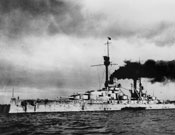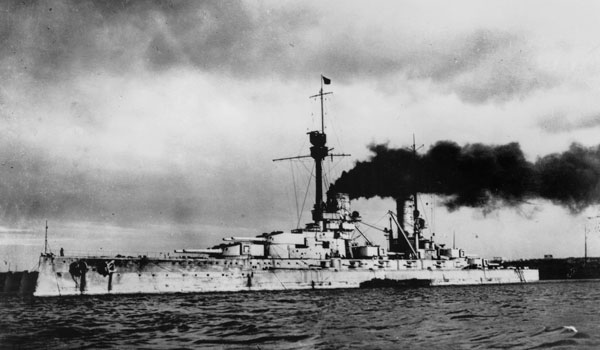History of SMS Kronprinz Wilhelm
Kronprinz Wilhelm was initially Kronprinz, becoming Kronprinz Wilhelm in 1918 in honour of Crown Prince Wilhelm. The ship was a König class battlecruiser, one of four ships of this class. The others were König, Grosser Kurfürst and Markgraf.
Kronprinz was laid down in Kiel in 1911, launched in February 1914 and commissioned in August of that year.
On 8 May 1915 she suffered a premature barrel explosion in one of its guns, but no significant damage was caused.
In April 1916 the ship supported a German raid on Lowestoft and Great Yarmouth along the east coast of England.
The battleship took part in the Battle of Jutland, the largest naval battle of World War I, fought on 31 May and 1 June 1916. Despite being part of the vanguard of the fleet, Kronprinz remained unscathed and suffered no loss of life.
As part of III Squadron, Kronprinz attended the recovery attempt for two German submarines, U-20 and U-30, stranded off the Danish coast. On the ship's return trip to the Baltic she was torpedoed by the British submarine J1. Kronprinz spent a month in drydock in Wilhelmshaven for repairs.
The battleship was accidently rammed by sister ship Grosser Kurfürst in March 1917, allowing 600 tonnes of water to flood into her, and so returned to drydock in Wilhelmshaven for more repairs.
By October of that year Kronprinz was taking part in Operation Albion, planned to eliminate the Russian naval forces holding the Gulf of Riga in the Baltic Sea. Kronprinz engaged the Russian pre-dreadnought battleship Graschdanin, managing to hit the Russian ship twice but remaining undamaged itself.
On 15 June 1918 she was renamed Kronprinz Wilhelm but, just over five months later, on 19 November, she left Germany for the last time bound for Britain and her final resting place, Scapa Flow.
- Nationality: German
- Launched: 21 February 1914
- Commissioned: 8 August 1914
- Builder: Germaniawerft, Kiel
- Construction No: 182
- Type: Battleship
- Subtype/class: König Class
- Displacement (Standard): 25,797 tonnes
- Displacement (Full Load): 29,669 tonnes
- Length Overall: 146m *
- Beam: 28m
- Draught: 6-8.5m
- Complement: 1,136**
- Material: Steel
- Cause Lost: Scuttled
- Date lost: 21 June 1919. 1315 hrs
- Casualties: One killed
- Propulsion: Three oil-fired and 12 coal-fired marine-type boilers. Three sets of Parsons turbines. Three propellers
- Fuel: 3,000 tonnes coal, 600 tonnes oil
- Power: 46200 shp
- Speed: 21 Knots
- Range: 8,000 nautical miles at 8 knots
- Armour: Deck 60-100mm. Forward control tower 300mm (on sides). Lower belt 350mm. Upper belt 180mm. Turrets 300mm (sides). Casemate 170mm
- Armament: 10 x 30.5 cm guns in five twin-turrets. 14 x 15 cm casemate guns. 10 x 8.8 cm anti-aircraft guns (six removed after Jutland). 5 x 50 cm submerged torpedo tubes
* Measurements taken from ship's plans
** The ship would carry an extra 82 men if the squadron flagship
NB: Torpedo nets were fitted to all König Class ships. These were removed after the Battle of Jutland, having proved cumbersome and inadequate.












